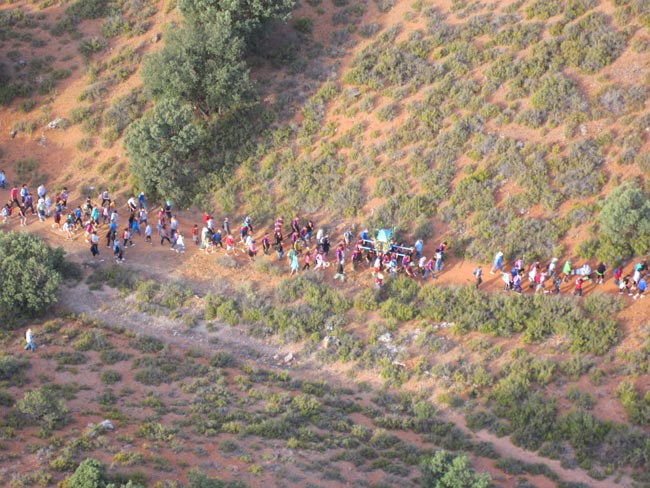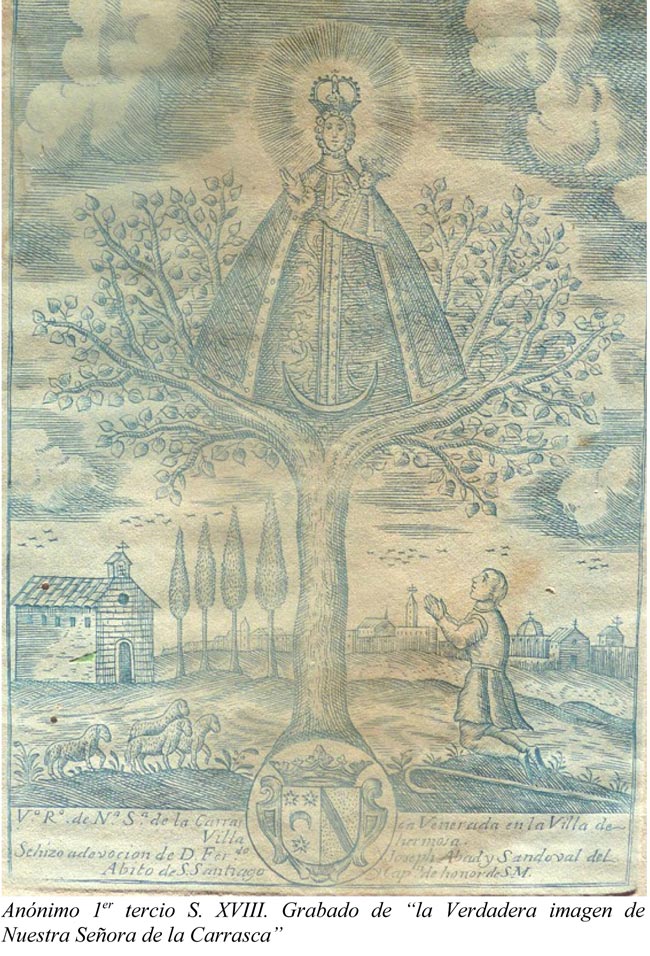Pilgrimage of the Virgen de la Carrasca

The second weekend of September is the celebration of the Pilgrimage of the Virgen de la Carrasca, one of the most important in Castilla - La Mancha, where fervor and tradition are mixed with fun.
The people of Villahermosa celebrate the pilgrimage in a privileged natural setting: the Sanctuary of Nuestra Señora de la Carrasca, where a multitude of activities are organized: open-air dances, bullfights, bullfighting and concerts.
What does the festival consist of?
The pilgrimage begins at dawn with mass in the church of the Assumption, subsequently moving the image of the Virgin with country hat from Villahermosa to the Sanctuary, accompanied by hundreds of people and carried on shoulders by the "quintos", while the "quintas" carry the flag of the Virgin and joyfully sing the songs to the patron throughout the journey.

The pilgrims follow the traditional dirt road, about 14 km, from Villahermosa to the Sanctuary. The first stop is at the hermitage of Azuer where the traditional lunch takes place. At noon, the arrival of the Virgin to the Sanctuary is one of the most emotional moments.
During four days the surroundings of the sanctuary are filled with the typical "huts" and tents, where the visitors and neighbors of Villahermosa stay during that time, enjoying from the first hour of the numerous acts and celebrations, gathering more than seventeen thousand people.

Days of celebration in which people sing and dance to the beat of the music band, popular melodies such as Entre cuatro mojoneras, Morena clara or Los Lagartos, which is a hymn in Villahermosa.
The image of the Virgen de la Carrasca remains in the Sanctuary until the last Saturday of April or first of May, when the Traída (pilgrimage or way back to Villahermosa) is celebrated, which begins early in the afternoon, making several stops to rest and regain strength, the most important being in the hermitage of Azuer, ending the pilgrimage at night in the parish of the village, the church of Nuestra Señora de la Asunción, where it will remain for the rest of the year.
Origin and evolution
The exact date when the hermitage that shelters Our Lady of the Carrasca was built is unknown. Already in the 15th century there are writings that mention the existence of a hermitage dedicated to Santa María de la Carrasca. The construction of this hermitage is due to the apparition of the Virgin.
The legend of the apparition of the Virgin begins with a character named José Cortés, a shepherd of the village who guarded a flock of sheep and lambs.

Every year this poor shepherd boy went to the city of Toledo with the intention of selling the offspring of his flock. Once in Toledo, he went to see the Cathedral, to visit the holy images that were there. The shepherd was so taken by the splendor of the Virgin that he had the idea of taking her to his homeland, Villahermosa, and so he did. In his attempt to steal the image of Mary, he was arrested and taken to the archbishop, who finally took pity on the poor shepherd boy and let him go back to Villahermosa.
The shepherd boy left in sorrow at not being able to take his Virgin Mary with him. But on the way to his homeland, the Virgin appeared to him in a holm oak tree, to alleviate his grief and to stay in Villahermosa.
The shepherd boy went to tell the people so that they could also see the miracle. It was there where the Sanctuary was built to house the Virgen de la Carrasca.
The proximity of the hermitage to other villages caused that, for years, there were several lawsuits about the ownership of the Hermitage. It is here where the legend of the predilection of the Virgin for Villahermosa is born, which relates that, among 4 mojoneras, each one belonging to its respective town, the Virgin chose Villahermosa to stay.
The beginnings of the Virgin's feast date back to 1530, although it was not yet understood as the current pilgrimage. It was a celebration in which a fire was made to eat and warm up, but above all to meet and have fun with friends and family around that bonfire. This congregation of people showed the need to have facilities in accordance with the volume of people who gathered there. Thus, the Hermitage became a Sanctuary.
Curiosities of the festivity

- The Virgin of the Carrasca is known by the Villahermoseños or calduchos as the Morenilla, due to her dark complexion.
- According to an article of the XVI century the effigy of the Virgin was golden and not as we know it now.
- At present it is the quintos (those who reach the age of majority) who have the exclusive privilege of carrying the Virgin in the transfer to the Hermitage.
- Between 1936 and 1939, due to the destruction and absence of the image, the celebration was not held.
- It is the only example of a sanctuary with a bullring, together with that of Las Virtudes (in Santa Cruz de Mudela), in the province of Ciudad Real.
What to see in Villahermosa and its surroundings?
Nuestra Señora de la Asunción Church: this is one of the most beautiful architectural jewels of Villahermosa, declared of Cultural Interest and National Monument in 1991. Inside the church we can find an 18th century Iberian Organ, an authentic Baroque jewel.
Sanctuary of Nuestra Señora de la Carrasca: it is a typical Hispanic Baroque devotional center, in whose vicinity the pilgrimage of the Carrasca is celebrated.
The White Lagoon (La Laguna Blanca): in the municipality of Villahermosa, 16 km away, is the first of the lagoons that make up the Lagunas de Ruidera Natural Park, known as the Oasis of La Mancha.
Villages of Cañamares and Santa María: they are located in a natural place of great beauty, where the density of the riverside vegetation intermingles with the limestone soil and the flora typical of the Mediterranean.
Heritage of La Mancha architecture: Villahermosa has some examples of architecture that show its noble past and that are worth visiting, such as the 15th century Casa del Comendador, the 15th century Casa del Marquesado, the 16th century Casa del Arco, the 17th century Casa de Márquez or the 16th century Casa de los Poblador.
Hermitages of Villahermosa: we can visit the Hermitage of San Agustín dedicated to the Patron Saint of the town, from the 16th century, which has a magnificent Renaissance-Marianist façade made of sandstone rock, the Hermitage of Azuer that is used for rest during the pilgrimage of the Virgen de la Carrasca, the Hermitage of San Antón, the Hermitage of San Isidro, the Hermitage of Santo Cristo, the Hermitage of Santa Ana, the Hermitage of San Sebastián or the Hermitage of the Virgen de los Dolores.
Gastronomy and typical dishes
The gastronomy of Castilla-La Mancha is known worldwide because some of its dishes appear in the work of Cervantes, Don Quixote De La Mancha.
It is a simple cuisine, of humble and pastoral origin, which uses local and high quality products.
Here are some of the most typical Manchego ducks from Villahermosa.
Pisto manchego: it is made from a base of tomato and green bell pepper, to which other vegetables such as zucchini, onion or eggplant can be added. It is served hot or cold and can be accompanied with a fried egg.
Caldereta de Cordero: this is a stew with lamb of the Manchega breed (Protected Geographical Indication), garlic, onion, wine and spices, which was traditionally cooked in large cauldrons over a good wood fire, a custom that still survives in many towns such as Villahermosa.
Migas: it is a simple but nutritious dish, based on bread, garlic, salt and, if you like, chorizo or bacon. It is usually accompanied by grapes, melon, pear or cucumber.
Gachas: an ideal dish for rainy days or intense cold. It is a simple recipe made with almond flour, paprika, oil, garlic, water and salt. They are usually accompanied by a plate of fried bacon. The custom is to eat them directly from the pan with a slice of bread.
Gazpachos manchegos or Galianos: it is a brothy stew served hot. Its main ingredient is torta cenceña and game meat (rabbit, hare or partridge).
Lemon salad: it is a refreshing, depurative and revitalizing dish, ideal for hot days. It is prepared with lemon juice, lemon slices, garlic, onion, oil and salt.
Rosquillos fritos: their secret is to be crispy on the outside and tender on the inside. They are a typical sweet from La Mancha and Villahermosa.






